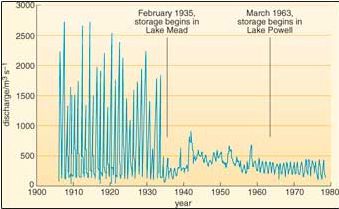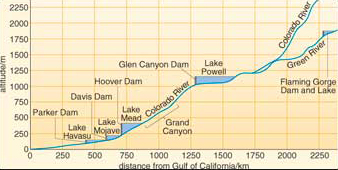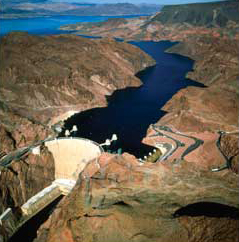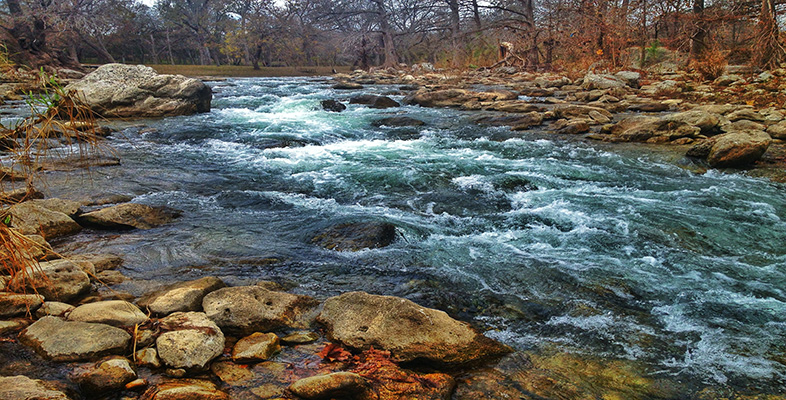3 Reservoirs
3.1 Introduction
The simplest and oldest way of storing surface water is in reservoirs and this has been done for thousands of years. Most reservoirs are still built to increase water supplies, but some are also built for other purposes, especially for generating hydroelectric power and for protection against floods. The Tennessee River in the United States, for example, has reservoirs to trap and store water that would otherwise cause floods, the water being released when the height of the river falls to safe levels. The Aswan High Dam in Egypt is used both to generate electricity and reduce flooding, as well as to provide water for irrigation.
Most older reservoirs, particularly in the UK, are direct supply reservoirs; they store water for steady release by pipeline to the public supply. Many of the newer reservoirs are for river regulation (Box 2); stored water is released into rivers when the natural discharge is low, so that it can be abstracted for use further downstream. The river itself transports the water from the reservoir so a pipeline is unnecessary. Unregulated, the discharge in winter exceeds requirements, but by storing winter water the scheme provides more water in summer than would be naturally available in the river. The Clywedog reservoir on a tributary of the River Severn, for example, was built to store up to 50 million m3 of water in winter, releasing it during the summer. This is needed because, as Figure 10 shows, the summer discharge is only around 20 m3 s−1 downstream at Bewdley, whereas in winter about 120 m3 s−1 are discharged. Both direct supply reservoirs and river regulation reservoirs may be pumped storage reservoirs, which do not fill naturally from a river, but have water pumped up to them. Many of the reservoirs in the Thames Valley are pumped storage reservoirs.
Box 2 The Colorado River
The change in river discharge patterns caused by river regulation reservoirs can be seen on a long-period hydrograph of the Colorado River in the USA (Figure 11). The Colorado is a large river (its annual discharge is about ten times greater than the River Severn, Figure 10) and has great seasonal fluctuations: in 1920, for example, its discharge varied from 50 to 2600 m3 s−1. This seasonal variation is caused by mountain snowmelt in the upper parts of the Colorado catchment in Wyoming, Colorado and Utah.

Downstream, the Colorado River flows through desert and its water is very important, but most of this flow was in the winter, when it was less useful for irrigation. Annual flooding was also common. To regulate the river flow, prevent flooding and to generate hydroelectric power, dams were built on the Colorado to create reservoirs (Figure 12). The first major dam, the Hoover Dam (Figure 13), was completed in 1935, forming the reservoir of Lake Mead. This holds most of the spring snowmelt and prevents very high discharges and flooding.


How did the discharge change after the creation of Lake Mead reservoir?
The peak discharge was reduced to about 800 m3 s−1 : much lower than previous highs of up to 2800 m3 s−1 before 1935.
How has Lake Mead affected the lower discharges of the Colorado?
These have increased, from typical values of 100-200 m3 s−1 before 1935, to 300-500 m3 s−1 from 1942 to 1955.
Raised lower discharges are because Lake Mead is a river regulation reservoir: water is released downstream into the river at a more constant rate than in the unregulated flow. Lake Mead is also a direct supply reservoir, supplying water by pipeline to eastern Nevada, and for hydroelectric power generation.
Even after the completion of Lake Mead there were still times when floodwaters filled the lake and were released downstream.
In which years, after 1935, did this happen?
There were peak discharges (although much lower than the pre-1935 peaks) in 1938, 1942, 1953 and 1958.
Another major reservoir, Lake Powell, was created upstream of Lake Mead in 1963 to trap this excess floodwater (Figures 11 and 12). Lake Powell is also used for water supply and hydroelectric power as well as river regulation. Since 1963, although there are still seasonal variations in flow, these are relatively small, with maximum flows of around 400 m3 s−1 and minimum flows of around 200 m3 s−1.
The multipurpose nature of the Colorado dams can cause particular problems. For example, although the dams have mostly eliminated the flooding along the lower Colorado, the reservoirs are often full in winter (with water being held for water supply use in summer) so no longer have the capacity to hold unexpected floodwaters.
The reservoirs trap most of the sediment behind the dams, which not only reduces the reservoir capacity, but also leaves the river below the dam lacking in nutrients and unable to support properly an aquatic ecosystem. The reservoirs are also polluted from heavy metals in the sediment (that would otherwise have been transported out to sea) and by oil, from recreational boats on the reservoirs. These factors have caused serious concerns about the environmental effects of big dams (Section 3.4).
